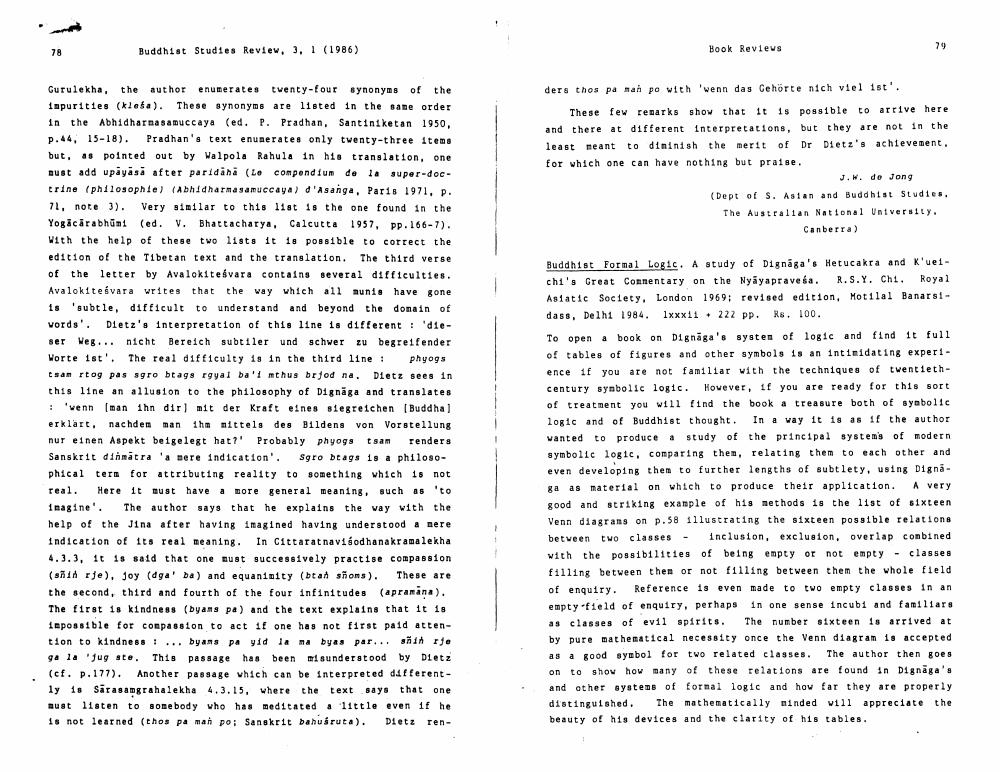Book Title: Die Buddhistipchabriefilteratur Indiens Author(s): Publisher: View full book textPage 2
________________ 79 28 Buddhist Studies Review, 3, 1 (1986) Book Reviews ders thos pa man po with 'wenn das Gehorte nich viel ist'. These few remarks show that it is possible to arrive here and there at different interpretations, but they are not in the least meant to diminish the merit of Dr Dietz's achievement, for which one can have nothing but praise. J.w. do Jong (Dept of S. Asian and Buddhist Studios, The Australian National University, Canberra) Gurulekha, the author enumerates twenty-four synonyms of the impurities (klesa). These synonyms are listed in the same order in the Abhidharma samuccaya (ed. P. Pradhan, Santiniketan 1950, p.44, 15-18). Pradhan's text enumerates only twenty-three items but, as pointed out by Walpola Rahula in his translation, one must add upayasa after paridana (le compendium de la super-doctrine (philosophie) (Abhidharma samuccaya) d'Asanga, Paris 1971, p. 71, note 3). Very similar to this 1180 18 the one found in the Yogacarabhumi (ed. V. Bhattacharya, Calcutta 1957, pp. 166-7). with the help of these two lists it 18 possible to correct the edition of the Tibetan text and the translation. The third verse of the letter by Avalokitesvara contains several difficulties. Avalokitesvara writes that the way which all munis have gone 18 'subtle, difficult to understand and beyond the domain of words'. Dietz's interpretation of this line is different : 'dieser Weg... nicht Bereich subtiler und schwer zu begreifender Worte ist'. The real difficulty is in the third line : phyogs tsam rtog pas sgro btags rgyal ba'i mthus brjod na. Dietz sees in this line an allusion to the philosophy of Dignaga and translates : 'wenn man ihn dir] mit der Kraft eines siegreichen (Buddha) dem man ihm mittels des Bildens von Vorstellung nur einen Aspekt beigelegt hat?' Probably phyogst sam renders Sanskrit dinmatra 'a mere indication'. Sgro btags 19 a philosophical term for attributing reality to something which is not real. Here it must have a more general meaning, such as 'to imagine'. The author says that he explains the way with the help of the Jina after having imagined having understood a mere indication of its real meaning in cittaratnavisodhanakramalekha 4.3.3, it is said that one must successively practise compassion (snin rje), joy (dga' ba) and equanimity (btan snoms). These are the second, third and fourth of the four infinitudes (apramana). The first 18 kindness (byams pa) and the text explains that it 18 impossible for compa881on to act if one has not first paid attention to kindness : ... byams pa yid la ma byas par... snin rje ga la 'Jug ste. This passage has been misunderstood by Dietz (cf. p. 177). Another passage which can be interpreted differently 18 Sarasamgrahalekha 4.3.15, where the text says that one must listen to somebody who has meditated a little even if he 18 not learned (thos pa man po; Sanskrit bahusruta). Dietz ren Buddhist Formal Logic. A study of Dignaga's Hetucakra and Kueichi's Great Commentary on the Nyayapravesa. R.S.Y. Chi. Royal Asiatic Society, London 1969; revised edition, Motilal Banarsidass, Delhi 1984. 1xxx11 + 222 pp. Re. 100. To open a book on Dignaga's system of logic and find it full of tables of figures and other symbols is an intimidating experience if you are not familiar with the techniques of twentiethcentury symbolic logic. However, if you are ready for this sort of treatment you will find the book a treasure both of symbolic logic and of Buddhist thought. In a way it is as if the author wanted to produce a study of the principal system's of modern symbolic logic, comparing them, relating them to each other and even developing them to further lengths of subtlety, using Dignaga as material on which to produce their application. A very good and striking example of his methods is the list of sixteen Venn diagrams on p.58 illustrating the sixteen possible relations between two classes - inclusion, exclusion, overlap combined with the possibilities of being empty or not empty - classes filling between them or not filling between them the whole field of enquiry. Reference is even made to two empty classes in an empty-field of enquiry, perhaps in one sense incubi and familiars as classes of evil spirits. The number sixteen 18 arrived at by pure mathematical necessity once the Venn diagram 18 accepted as a good symbol for two related classes. The author then goes on to show how many of these relations are found in Dignaga's and other systems of formal logic and how far they are properly distinguished. The mathematically minded will appreciate the beauty of his devices and the clarity of his tables.Page Navigation
1 2
